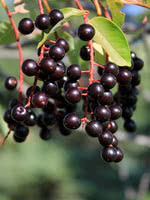Mon-Fri 9am - 5pm Mountain time
Western Chokecherry vs Meadowsweet
Prunus virginiana var. demissa
Filipendula ulmaria
SOLD OUT
CUSTOM GROW
Western Chokecherry is a shrub or small tree commonly used for farmstead and field windbreaks.
It produces white flowers in the spring and edible dark purple fruit that matures between September and October. Its cherries are great for making for making jams, jellies or wine, but are not very palatable for raw eating.
Meadowsweet gets its name from its sweet fragrance from the creamy white flowers. It is a large upright herbaceous perennial shrub. They bloom in early summer, and with the right conditions may remain throughout the season.
Take care of where you’re planting Meadowsweet as it is known to spread.
Western Chokecherry Quick Facts
Meadowsweet Quick Facts
Toxicity: toxic to horses, cattle, etc.)

